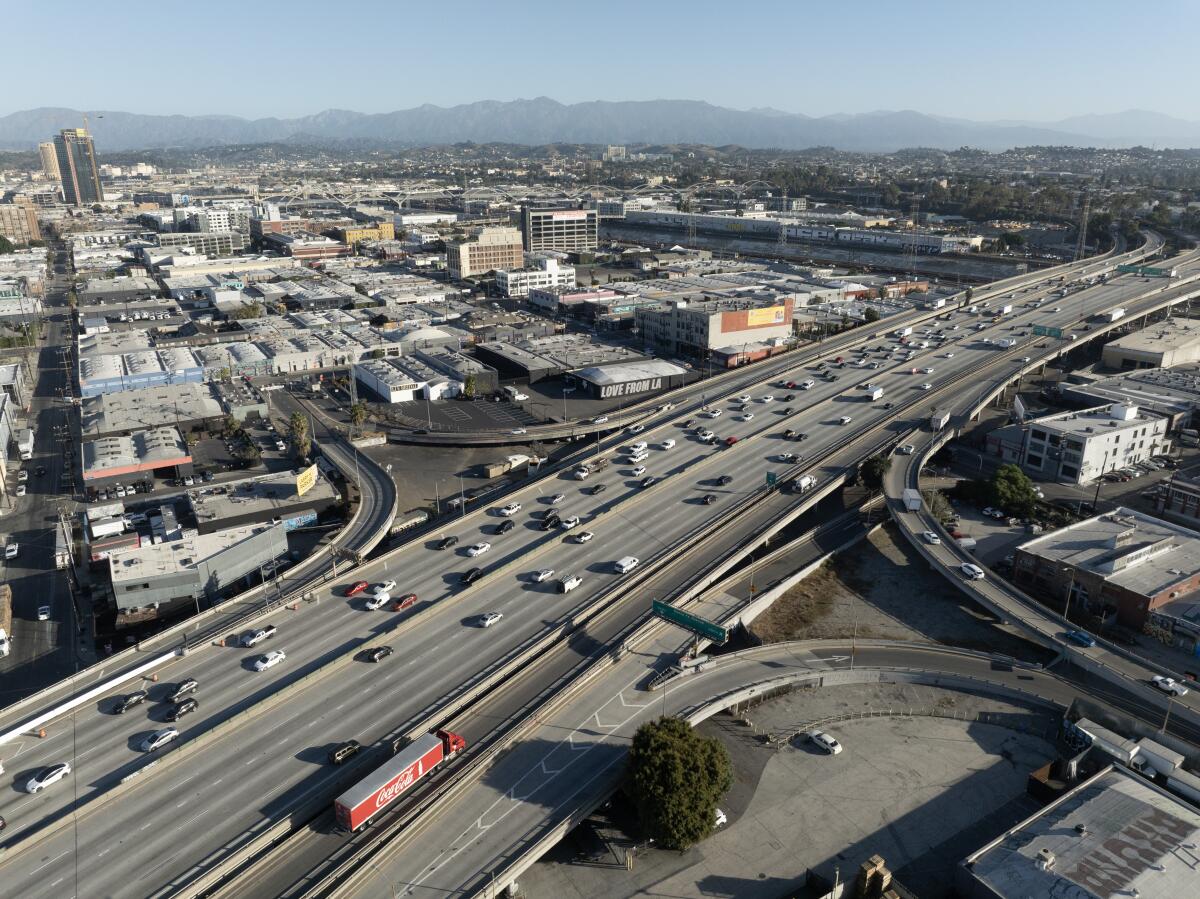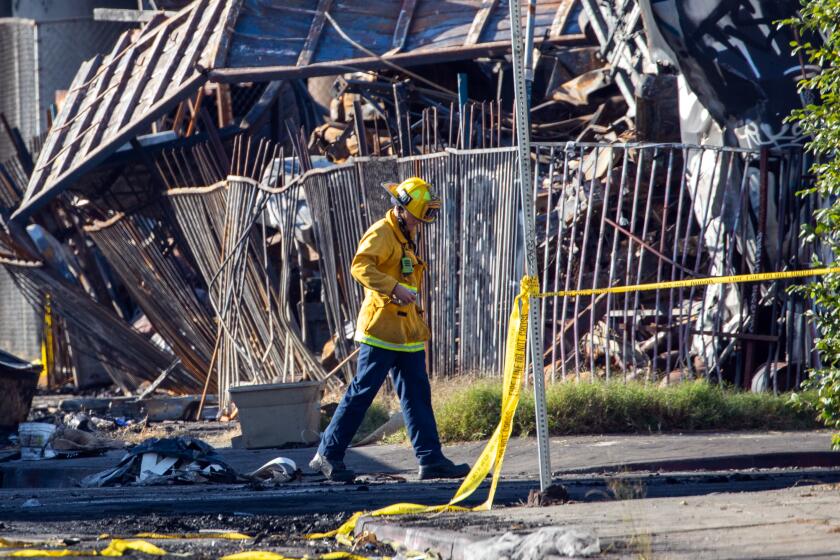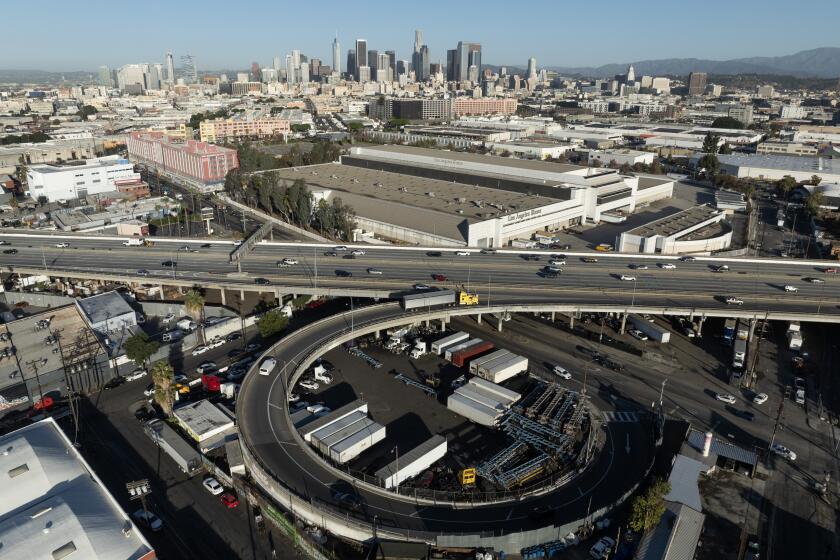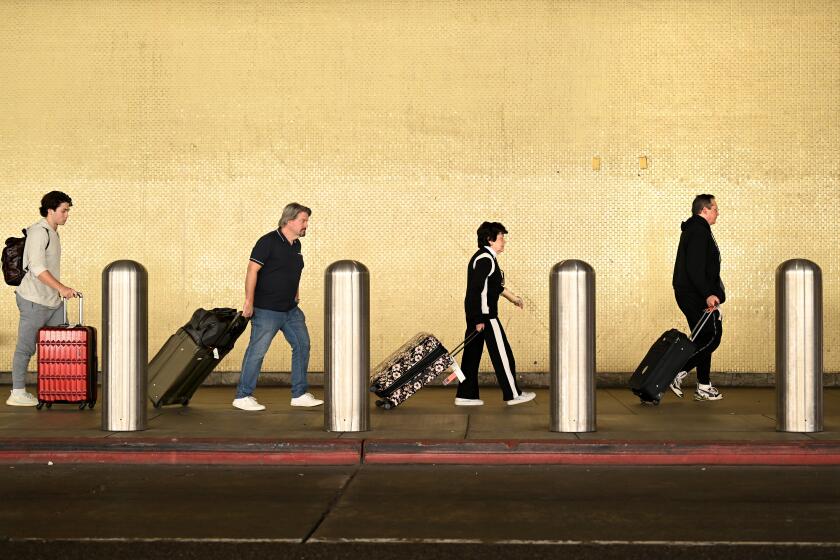The long road ahead to fix the fire-damaged 10 Freeway

- Share via
With traffic again flowing above, construction crews in hard hats and high-visibility vests are busy surveying the scene: the belly of the 10 Freeway in downtown L.A.
Here, where earlier this month a massive fire scorched the roadway, large timber and steel structures have been erected to take the weight off seven rows of damaged concrete columns.
But what is actually going on under the freeway?
For all the accolades officials gave for reopening the 10 in days rather than weeks, state leaders have publicly said little about the precise damage caused by the fire, exactly how Caltrans plans to make fixes and how much the repairs will cost.
Wood pallets under Interstate 10 concerned Caltrans for years at the site of the fire, which forced the freeway closure and put a spotlight on the state’s lease program.
Though the shored-up freeway is safe for drivers again, repairs for the damaged overpass will take months, officials said. None of the damaged columns that hold up the overpass east of Alameda Street have been repaired yet, according to Caltrans spokesperson Michael Comeaux.
“Columns damaged by the fire will need to be repaired. The repair strategy may vary between individual columns depending on the extent of damage. The repairs will include the removal of any damaged concrete, patching of the damage, and wrapping the columns with steel casings,” Comeaux said in an email.
The scene at the damaged overpass following the fire was a mess, with charred vehicles, hazardous materials and other debris strewn about. Caltrans engineers estimated the freeway would open in several weeks and not days “based on the results of previous project timelines, real-time site assessments, and the data available to them,” Comeaux said.
“Specifically, at that time, the repair estimate was based on visual observations of the damage and assumed the damage to the bridge girders was more extensive. Material test results later confirmed the damage to the bridge girders did not require as much shoring as originally anticipated,” he added.
Emergency crews raced to clear debris and hazardous materials after the Nov. 11 fire, which arson investigators believe was started intentionally on Caltrans property leased to a company that was subleasing it to a handful of small businesses. There, piles of wooden pallets were stored alongside combustible liquids, which was in violation of state regulations.
The fire has drawn scrutiny to the state’s open-air lease program. On Wednesday, Caltrans announced inspectors assessed 601 leased sites across the state and of 38 sites that pose a potential risk, only a few present a specific fire or safety risk.
The agency said it is “sending legal notices of non-compliance and requiring lessees to remediate identified violations. Arrangements have been made to inspect the remaining eight sites, which are not anticipated to present specific risks.”
“The department is conducting this urgent safety review of our leased Airspace properties across the state to assure the public that these spaces pose no threat to their safety or the integrity of our state’s critical infrastructure,” Caltrans Director Tony Tavares said in a statement.
In the following days after the pallet fire in Los Angeles, construction crews erected the shoring structures and road crews repaired damaged electrical systems, lane striping and signs on the freeway, and some damage to the freeway deck. Currently, engineers are developing a repair plan for the overpass, Comeaux said.
Commuters can again drive on the freeway, but repair work is still needed, and there will likely be incremental closures for repairs, officials say.
Caltrans did not immediately respond to requests for an interview with Caltrans experts about the work involved to repair the stretch of freeway, which carries roughly 300,000 daily commuters.
An engineer with Caltrans who was not authorized to speak publicly said 45 columns show clear evidence of spalling, the technical term for the cracking and disintegration of concrete when it is exposed to extremely high temperatures. The heat evaporates water molecules inside the concrete, which makes the material weak and brittle.
Construction crews will have to remove the damaged concrete from each column. In many cases, the engineer said, that damage extends to the reinforcing metal known as rebar that is embedded inside the concrete and spirals around vertical lengths extending from the foundation to the freeway overhead.
More than 55 million Americans are expected to travel over the next 10 days for the Thanksgiving holiday. Experts share their advice.
Engineers have identified eight columns where the heat of the fire reached far deeper into the concrete. For those columns, crews will have to remove not only the compromised concrete but also the spiral of rebar, the engineer said.
Once the damaged concrete and steel have been removed, the columns will be rebuilt, most likely with steel jackets similar to those used in seismic retrofits of bridge columns (an earthquake review in the 1990s did not lead to jackets being placed around the columns at this location). Grout or concrete will then be injected between the jacket and column.
Comeaux confirmed that Caltrans does not anticipate replacing any of the the columns damaged by the fire based on material testing and visual inspections by engineers.
“The limits of the impacted material to be removed will be established during the repair,” Comeaux said.
Officials emphasized throughout the closure and reopening that multiple agencies worked together to get the freeway reopened quickly and did not cut any corners to ensure drivers could travel on the freeway in time for the Thanksgiving holiday traffic surge.
“Let me just assure you that the reason why the freeway is going to be open quickly is because the deep structural damage that we were worried about did not take place,” L.A. Mayor Karen Bass said at a news conference on Friday. “There isn’t any reason to doubt that this freeway would not open if there was any concerns about safety.”
More to Read
Sign up for Essential California
The most important California stories and recommendations in your inbox every morning.
You may occasionally receive promotional content from the Los Angeles Times.
















